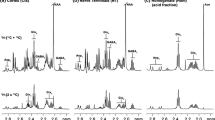Abstract
The uptake of 14C-labeled aminoglutethimide into the brain was investigated in the rat after intracarotid injection according to the method of Oldendorf, as well as in cisternal cerebrospinal fluid obtained by suboccipital puncture after i.v. injection of the drug. The brain uptake index of aminoglutethimide after intracarotid injection was 30.7 + 2.4%. Cerebrospinal fluid/blood quotients after i.v. drug injection were 0.53 at 10 min and 0.26 at 60 min. The results of both methods clearly show that aminoglutethimide easily penetrates the blood brain barrier.
Similar content being viewed by others
References
Longcope L, Pratt JH, Schneider SH, Fineberg SE: Aromatization of androgens by muscle and adipose tissue in vivo. J Clin Endocrinol Metab 46:146–152, 1978
Abul-Haji YJ, Iverson R, Kiang DT: Aromatization of androgens by human breast cancer. Steroids 33:205–222, 1979
Miller WR, Forrest APM: Estradiol synthesis by a human breast cancer. Lancet 2:866–868, 1974
Nicholls PJ, Dalrymle PD, Eweiss N, Douglas JS: Aminoglutethimide: absorption, physiological disposition and pharmacokinetics. In: Nagel GA, Santen RJ (eds): Aminoglutethimide as an aromatase inhibitor in the treatment of cancer. Hans Huber Publishers, Berne-Stuttgart-Vienna, 1984, pp 58–67
Rabe T, Bauer M, Kaufmann M, Runnenbaum B, Kubli F: Inhibition of aromatase activity in human breast carcinoma by aminoglutethimide in vitro (Abstract). Acta Endocrinol 102:146, 1983
Varela RM, Dao TL: Estrogen synthesis and estradiol binding by human mammary tumors. Cancer Res 38:2429–2433, 1978
Oldendorf HW: Measurement of brain uptake of radio-labeled substances using a tritiated water internal standard. Brain Res 24:372–376, 1970
Unger C, Eibl H, von Heyden HW, Nagel GA: Ein neues Prinzip zur Überwindung der Blut-Hirn-Schranke. In: von Heyden HW, Krauseneck P (eds): Hirnmetastasen, Pathophysiologie, Diagnostik und Therapie. Zuckschwerdt Verlag, München, 1984, pp 31–38
Reiber H, Schunck O: Suboccipital puncture of guinea pigs. Laboratory Animals 17:25–27, 1983
Oldendorf HW: Lipid solubility and drug penetration of the blood-brain barrier. Proc Soc Exp Biol Med 147:813–816, 1974
Perel E, Wilkins D, Killinger DW: The conversion of androstendione to estrone, estradiol, and testosterone in breast cancer tissue. J Steroid Biochem 13:89–94, 1980
Unger C, Eibl H, von Heyden HW, Nagel GA: Reversible opening of the blood-brain barrier for drug transfer by short chain alkyl glycerols. (Abstract) Proc Am Soc Clin Oncol 3:25, 1984
Author information
Authors and Affiliations
Rights and permissions
About this article
Cite this article
Unger, C., Eibl, H., von Heyden, HW. et al. Aminoglutethimide. Invest New Drugs 4, 237–240 (1986). https://doi.org/10.1007/BF00179589
Issue Date:
DOI: https://doi.org/10.1007/BF00179589




